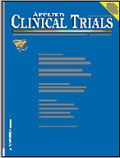EU-Born HIV Study: History in the Making
Ten-year-old study sets precedent for future collaborative observational studies on drug safety.
There has been widespread satisfaction at the decision in February to continue the DAD study (Data Collection on Adverse Events of Anti-HIV Drugs).

Peter O'Donnell
This prospective study of HIV-infected persons under active follow-up has been underway since 1999, based on multinational cohort collaboration. When it started, the study was designed as a collaborative review of the cardiovascular safety and metabolic and body composition changes possibly associated with HIV treatment.
The scope of the study was extended in 2005 to include investigation of liver-related safety. It now includes data from 33,308 patients in 11 ongoing HIV cohorts in Europe, Australia, and the United States.
The study now monitors all authorized antiretroviral medicines. In addition, the marketing authorization holders for any new antiretroviral medicines authorized in the future will be required to take part in the study.
DAD in the details
The data collection for DAD takes place at least every eight months. Each cohort gathers and computerizes its data, subsequently merging it into a database at the Copenhagen HIV Programme (CHIP), a research unit at the Faculty of Health Sciences University of Copenhagen.
The core data in the study is information on cases of cardiovascular disease, which are reported immediately to the local cohort coordinating office, using event reporting forms. The data collection also includes information on risk factors for cardiovascular disease, such as previous myocardial infarction or stroke, hereditary tendency, smoking status, diabetes mellitus, dyslipidemia, and hypertension.
An association between antiretroviral combination therapy and myocardial infarction was identified in 2003. Further follow-up established that this was mainly explained by cumulative exposure to protease inhibitors. More recently an association with the recent use of abacavir and didanosine was found and is being further investigated.
The study will also be expanded to consider whether antiretroviral medicines affect the risk of contracting non-AIDS defining cancers and end-stage kidney disease, as well as to examine patterns of causes of death over time and laboratory markers of liver and kidney function.
Although marketing authorization holders of antiretroviral medicines contribute to the funding of the study, it is run in scientific independence, ensured by an independent scientific steering committee, which takes all scientific and procedural decisions.
The Oversight Committee for The Evaluation of Metabolic Complications of Highly Active Antiretroviral Therapy (which includes representatives of academia, patient organizations, the European Medicines Agency (EMEA), and U.S. FDA administers the funds for studies, follows their progress, and ensures their completion.
European pride
The EMEA greeted the decision to continue the study with particular enthusiasm. As it points out, "the DAD study was started in response to a request from the EMEA to all marketing authorization holders of antiretroviral medicines." In addition, the oversight committee reports to the EMEA on progress.
The renewed commitment of the sponsors should ensure that the study continues at least until 2012 and "will remain one of the most powerful pharmacovigilance tools to monitor the long-term safety of antiretroviral medicines."
The announcement of the extension in early February came days after the January meeting of EMEA's Committee for Medicinal Products for Human Use—at which representatives of the oversight committee and steering committee presented the achievements made over the past 10 years and the plans for the study's continuation.
There is no doubt in the EMEA's mind about the importance of the study. "Due to its large size and long follow-up, the DAD study has had a pioneering role in drug safety, helping to address existing and new emerging safety concerns, as well as to learn more about HIV infection itself," the agency said in a statement. And looking ahead further, it added: "This is likely to serve as a model for future collaborative observational studies that will analyze the safety of whole therapeutic classes of medicines."
Advanced therapies
Meanwhile, Europe has been moving ahead on another front.
During January it held the first meeting of its new Committee for Advanced Therapies (CAT). This is a multidisciplinary committee, bringing together some European expertise to assess the quality, safety, and efficacy of advanced therapy medicinal products (ATMPs) and to follow scientific developments in the fields of gene therapy, somatic cell therapy or tissue engineering and of the new treatment opportunities they offer.
It has been set up in line with the European Union's new rules on these products, adopted in 2007, which is designed to allow these medicines to access the EU-wide market without delays or difficulties arising from divergent national evaluations.
This is the sixth scientific committee to be set up at the EMEA, and the agency's Executive Director, Thomas Lönngren, greeted it as "a milestone in the history of pharmaceutical regulation in Europe."
In his view, "Some of the best experts in the field of advanced therapies will be working together so that patients suffering from serious diseases and injuries across the EU can safely benefit from revolutionary new treatments. Their work will help pharmaceutical companies, in particular small and medium-sized ones, to unleash their innovative potential and bring new medicines to the market."
Companies developing advanced therapies hope he is right. The history of European Union regulation of medicines is marred by so many episodes of dissension among its member countries, and so many false starts in reaching a common approach. As a result, the default state for observers of the European pharmaceutical scene is skepticism whenever claims are made of milestones being reached.
The CAT will have a pivotal role in fulfilling the objectives of the legislation. One of its main tasks is to prepare a draft opinion on each ATMP application before the Committee for Medicinal Products for Human Use adopts a final opinion on a marketing authorization for the medicine concerned.
Its membership comes largely from the EMEA's committees and the EU member states, but it also has representatives from European clinicians and patient associations.
There is no representation for industry or for the clinical trials community as such, so its work will be very closely scrutinized by those working on developing these new "milestone" medicines.
Pediatrics patrol
Another of Europe's new institutions is still finding its way toward consistent regulation of medicines—the EMEA's committee on pediatric medicines.
The applications are starting to pour in for approval of the pediatric investigation plans that companies are now obliged to submit, and at its January meeting the committee dealt with another wave of opinions on proposals for them.
It approved plans for a dozen products, including Organon's asenapine maleate in psychiatry; Roche's methoxy polyethylene glycol-epoetin beta in uro-nephrology; Novo Nordisk's PEGylated recombinant Factor VIIa in hematology; Genzyme's Plerixafor and Pfizer's sunitinib malate in oncology; and Janssen-Cilag's ustekinumab in dermatology.
In addition, the committee agreed on product specific waivers for Novartis Europharm's aliskiren hemifumarate/hydrochlorothiazide in cardiovascular diseases, and Glaxo's lapatinib ditosylate monohydrate and Eli Lilly's pemetrexed disodium in oncology. It recommended that the obligation to submit data obtained through clinical studies with children be waived in all subsets of the pediatric population for these medicines.
Waivers can be issued if there is evidence that the medicine is likely to be ineffective or unsafe in the pediatric population; that the disease or condition targeted occurs only in adult populations; or that the medicine does not represent a significant therapeutic benefit over existing treatments for pediatric patients. [But a request for waiver from Shire Human Genetic Therapies for its velaglucerase alfa in endocrinology/gynecology/fertility metabolism was turned down.]
During January the obligations relating to pediatric investigation plans became tighter too.
Since last July, pharmaceutical companies applying for a marketing authorization for a medicine have had to provide either the results of studies in children conducted in accordance with an approved plan, or an EMEA decision on a waiver or on a deferral.
As from January 2009, this also applies to medicines that are already authorized and for which a company is submitting an application for an extension of indication, or for a new route of administration, or for a new pharmaceutical form.
Peter O'Donnell is a freelance journalist who specializes in European health affairs and is based in Brussels, Belgium.

FDA Fast Tracks Johnson & Johnson’s Nipocalimab for Fetal Neonatal Alloimmune Thrombocytopenia
March 27th 2024Johnson & Johnson is moving forward with a pair of Phase III trials of nipocalimab to reduce the risk of fetal neonatal alloimmune thrombocytopenia in alloimmunized pregnant patients.